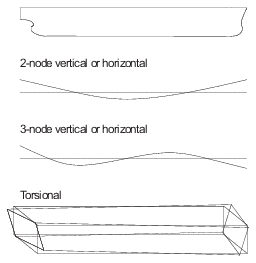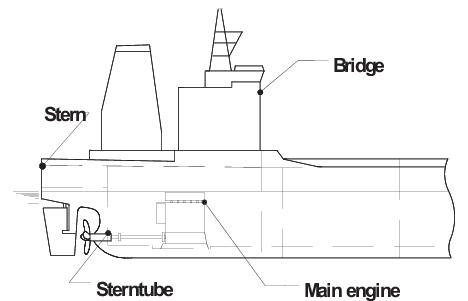1.1
Resonance
A ship’s hull will respond to exciting forces and moments
as a beam freely supported in water. The modes are described by the
plane of vibration and the number of nodes (points of no deflection);
for example, the two-node vertical,
Figure 4.1.1 Hull girder modes of vibration
. Frequencies are low, typically in the range 1-10
Hz. The excitation may come from engine external forces or moments,
propeller pressure impulses or, irregularly, by waves. Wave excitation
frequencies are typically 1-2 Hz.
At resonance, when excitation
and hull girder natural frequencies coincide, dynamic magnification
may result in large amplitudes of vibration for comparatively low
excitation.
Hull girder natural frequencies are dependant
on the stiffness and mass of the structure and the virtual added mass
of water. They vary with changes in draught, trim, and mass distribution.
Resonances above the normal operating speed of the vessel in ballast
may move down the speed range and become troublesome in the loaded
condition.
Investigation of hull girder vibration is fundamental
to identification of the possible causes of high shipboard vibration.

Figure 4.1.1 Hull girder modes of vibration
1.2
Measurement
positions
It is normal to measure hull girder response at the stern or,
alternatively, at the sterntube,
Figure 4.1.2 Measurement positions
. Measurements at the sides will allow torsional
hull modes to be identified and simultaneous measurements at the wheelhouse
and the main engine (if a slow speed diesel) will provide additional
information about superstructure and engine modes.

Figure 4.1.2 Measurement positions
1.3
Avoidance
of resonance in service
Resonances of the ship’s structure are normally lightly
damped and finely tuned so that an adjustment of the shaft speed by
a few revolutions either way may reduce the response. It may be possible
to alter the frequency or magnitude of the excitation source, for
example, changing the number of blades on a propeller or changing
to a highly skewed or tip-unloaded propeller blade form. It is generally
not practical to change the natural frequencies of hull girder modes
by altering the steelwork or to reduce the response by additional
damping.
1.4
Avoidance
of resonance by design
3-D finite element analysis can be used at the design stage
to model a ship’s structure. Reliable estimates can be made
of natural frequencies which might be excited at service speed. Campbell
diagrams are a useful tool here in plotting excitation and response
frequencies.
1.5
Forced vibration
Forced vibration may occur when propeller pressure impulses
or engine external forces and couples are large. Amplitudes increase
with transmitted shaft torque and are generally proportional to the
square of the speed with a fixed pitch propeller. A reduction in the
excitation level is usually necessary if forced vibration levels are
excessive.